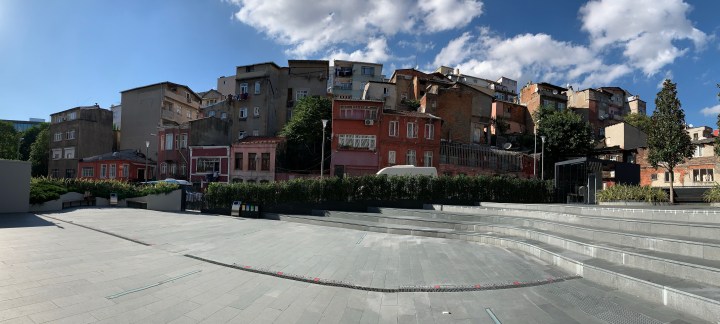Op-Ed
What good is art if it satisfies only the imaginaries of artists?

Arty spaces are often positioned in neighbourhoods marked by poverty, unemployment and alienation, with declarations of good-neighbourliness, vibrancy and inspiration. But they are often just a beachhead for gentrification, which sees local communities forced out.
I sat down to write this column on Monday, 24 hours before the agreed deadline. I would not be able to write on Tuesday because I was to have surgery on my right hand for recurrent complications with carpal tunnel syndrome. It comes with the job. My original idea for a column was to focus on the disbelief among ANC followers and true believers, that their party would have the audacity to present policies that were similar to those of the DA.
But then there appeared a passage on Daily Maverick’s main page – those quotes that appear randomly between articles – that took the act of writing in a different direction.
The quote was: “Art for art’s sake is an empty phrase. Art for the sake of truth, art for the sake of the good and the beautiful – that is the faith I am searching for.” It was a passage by George Sand (the pen name of Amantine Lucile Aurore Dupin). It took me back a few weeks, to when I visited Istanbul and an image of one particular gallery that had remained with me. It also took me back, as it were, to District Six and Zonnebloem.
Before I return to Istanbul, I should explain how I approached the visit to the Arter Gallery I describe below. For the reader who is easily annoyed by academic-speak, I apologise. There are very many clever people, and people who think they’re clever, who would conspire to project all their own values onto what others write.
To be clear, my visit to the Arter (and Istanbul for the most part), was driven by a type of Husserlian phenomenology (the reference is to the German philosopher, Edward Husserl, founder of the school of phenomenology). I really should not dive too deep into that, suffice to say that, consistent with phenomenology, I approached the Arter without any conceptual baggage so as to avoid any extraneous stuff, and get to the heart of the experience.
I went there for the art. So, all my own ideological baggage was stored in the locker with my backpack.
But then that passage by George Shand on Daily Maverick’s site on Monday, during a visit to Zonnebloem with its art galleries and coffee shops, intruded. Somehow it carried me back to the Taksim, Gezi Park, and especially the Arter Gallery in Istanbul.
Art gallery and art spaces as beachhead for gentrification
The Arter Gallery reminded me of the gentrification of neighbourhoods where unemployment, poverty, alienation are rife, and where (in the case of Dolapdere, where the gallery is located) the gleaming gallery stands, egotistically separate. I should not traduce the creativity that is on exhibit at the Arter Gallery, but I can also not see it in isolation from Dolapdere, and the forced gentrification of poor neighbourhoods; the way that a section of District Six has now become Zonnebloem, home to art galleries, artisanal coffee shops, and nude foods.
The location of the Arter Gallery is in a neighbourhood of Istanbul that is home to poverty, alienation, of Kurdish and African refugees and is especially distressing. I am sure than none of the homeless people who want to sit down and have a cappuccino at a trendy Zonnebloem café (if she has the money) would be welcome. And so, the Arter encourages the local community to visit the gallery at low cost or even for free. But step outside the back door (outside the coffee shop) and onto the black flooring of the back court of the Arter Gallery – and see how it stretches, in some places for no more than 10 metres, in clean lines, neat angles to a low wall, beyond which children play amid impoverished surroundings and dilapidated buildings.

Caption: The view from the back court of the Arter Gallery is of Dolapdere. One of the poorer neighbourhoods of Istanbul home to refugees and marginalized communities. The surveillance cameras are permanent fixtures and are magnified, here, only to draw attention to them. Photograph by Ismail Lagardien
The Arter acknowledges its intrusion. It wants to be “a sustainable vibrant cultural hub”, and insists on being a good neighbour collaborating in “exploratory research on the social and cultural structure of the neighbourhood as well as the expectations, hopes and worries of our neighbours concerning Arterʼs [location in] Dolapdere”. We should take their word on that.
Nonetheless, Dolapdere (and neighbouring Tarlabaşı) is more than a working-class district beset by poverty, it has become a home and a sanctuary for transsexual people, sex workers, Kurdish and African refugees displaced from one area that had been regentrified (like Tarlabaşı) to another, Dolapdere. They now live in the shadow of the Arter Gallery.
In both areas, Tarlabaşı and Dolapdere, “the social and economic profile of the residents is remarkably low, accompanied by poverty, physical and socio-economic deprivation, poor infrastructure, unemployment, informal working, and higher illiteracy rates,” Oktem Unsal of Mimar Sinan Fine Arts University, Turkey, found in 2015.
Such conflict and tension do not seem to be part of the ecosystem of a curated city. I have always had the sense that a curated city is necessarily an ecosystem, at least conceptually, and that it has to be strengthened and enhanced culturally and economically by purposeful intervention by the state. The problem with Arter, at least in my mind, is the problem of Dolapdere, its proximity to Taksim and Gezi Park.
Malls competing with mosques in the gentrification of Istanbul
Istanbul’s cityscape is marked by mosque minarets, but below the skyline malls are being built, and old neighbourhoods are being destroyed. It is in these neighbourhoods that art galleries like Arter are popping up, serving as beachheads for gentrification.
Amid this “development” Istanbullus are “seething” and feel “overwhelmed and shunted aside” because of what they describe as a focus “on profit for the privileged while ignoring the majority”. Istanbullus see disappearing green spaces, overpriced apartments, forced evictions, longer commutes and a mushrooming of shopping malls competing with minarets and mosques.
It was, precisely, the proposal of a mall to be built on Gezi Park in Taksim, in the centre of Istanbul, that sparked protests in 2013, which spread nationwide. The locals wanted to retain the green spaces and prevent gentrification of their neighbourhoods. It is hard to shake the feeling that the Arter Gallery is part of that internal colonisation, as it were, of places like Dolapdere.
Back to Cape Town and District Six
I am not an artist, and I know little about the arts, in general. I do, however, have senses of displacement, of forced removals and knowledge of gentrification. I cannot shake off, or unthink, the homologies between District Six (or Zonnebloem) and Dolapdere – or, as a clever writer once wrote about what is now Zonnebloem, it is where “artists bullshit their way through [Cape Town’s] social and racial inequality”.
In 2014, Cape Town hosted the World Design Capital, “which sounds important and fancy”, as Ilham Rawoot wrote in an article, “The artists taking on gentrification in South Africa”. Yet, she explained, “Few locals understand what it actually does, but get that it cost the local government a load of cash to earn the trademark. The reinvigorated ‘design’ buzzword is being used to pander to the will of major property developers and trendy businesses moving into Woodstock and District Six – traditionally low-income black and coloured neighbourhoods with heavy histories.
“We’ve seen it before: businesses come in, rents and rates go up, communities move out, wealthy, mostly white people, move in and ‘clean up’ the neighbourhood … for cheap commercial and residential spaces, in good proximity and with good transport links to the CBD and the element of dodginess that is imperative for an artistic landscape. Gentrification is not new. The difference in Cape Town, though, is that it is frighteningly reminiscent of the forced removals during apartheid.”
In 2015, a journalist was asked to attend a meeting between a tenant, Carol White, who lives in one of the last remaining blocks of flats in District Six (along Philip Kgosana Drive). Wrote Deneel Knoetze: “She called me to sit in and listen to the [government] department’s presentation, as she wanted moral support and believed I could advise her on how the presentation would affect her life.
“The government official said: ‘It is decided that it is no longer viable for us to receive the rent we’re currently charging’.” The official (who asked not to be named) explained in his best officialese that all the flats would be refurbished and tenants who could afford “market-related rentals” under a new lease agreement were welcome to stay. If not, they had the option of relocating to (and owning property in) Pelican Park – a housing development in a poor area some 20km southeast of the city. [Where the Cape Flats meet the sea.]
“To White’s protests that a move to Pelican Park would spell disaster for her grandson entering matric next year, the response was: ‘Ma’am, we all have our problems. But we wouldn’t get our job done if we were to consider everyone’s problems. Have you seen the views from around here? We all want to live close to the city. But you can’t pay so little when people pay millions to be able to live around here. Just look at the views’.”
The view of the Arter Gallery, sitting in the centre of the Dolapdere, is of a building standing egoistically separate from the community. At what point, I wonder, will it become too expensive for local people to afford living in the shadow of the gallery – under the watchful gaze of surveillance cameras? DM

















 Become an Insider
Become an Insider